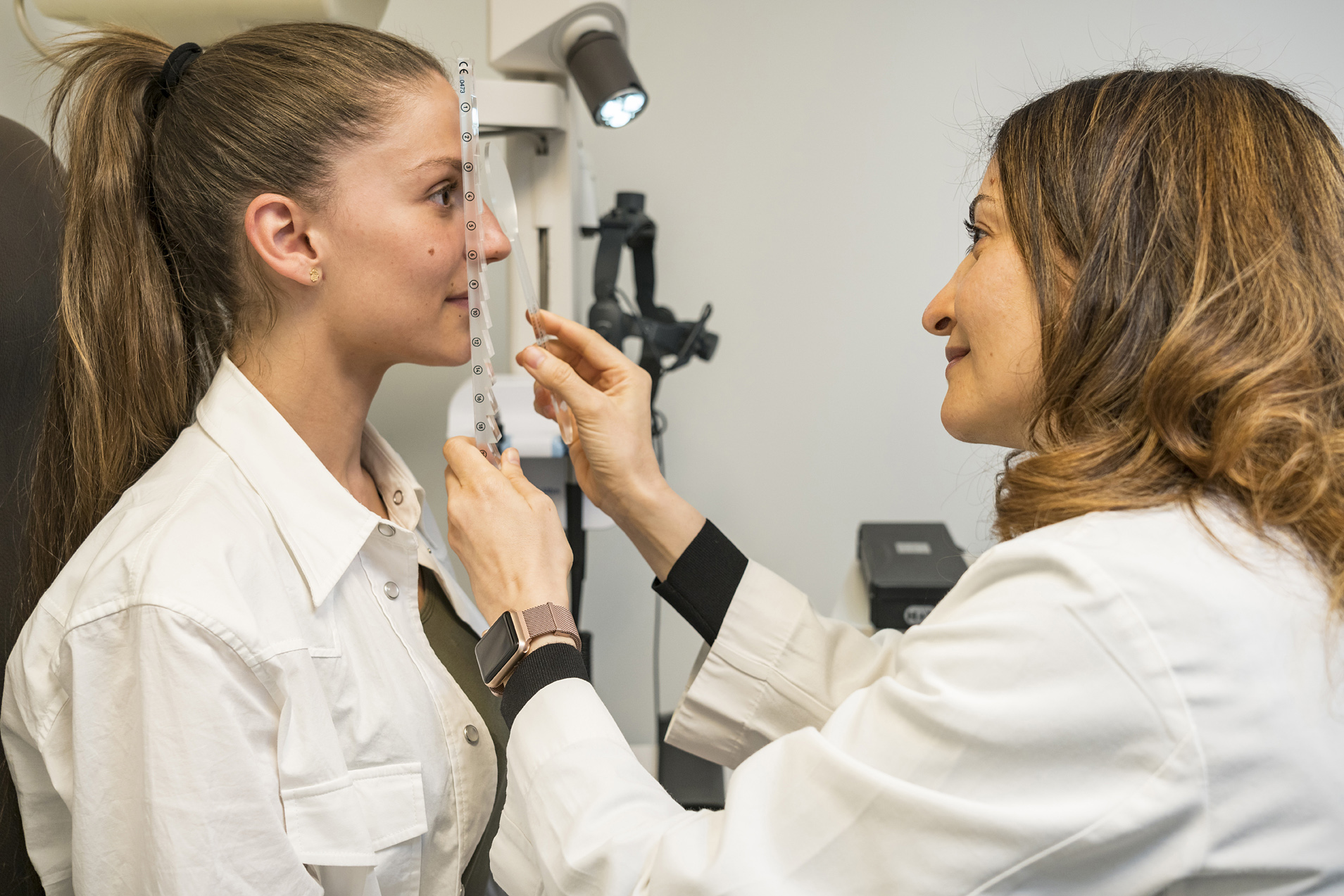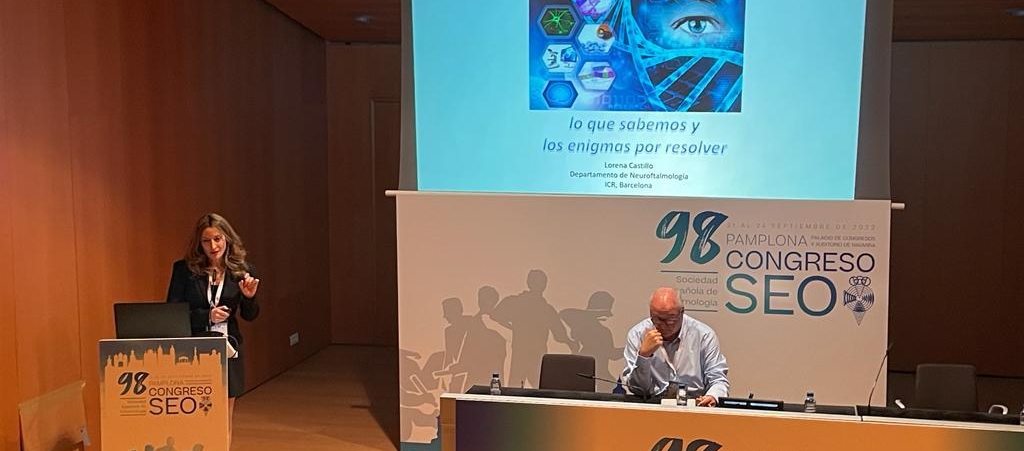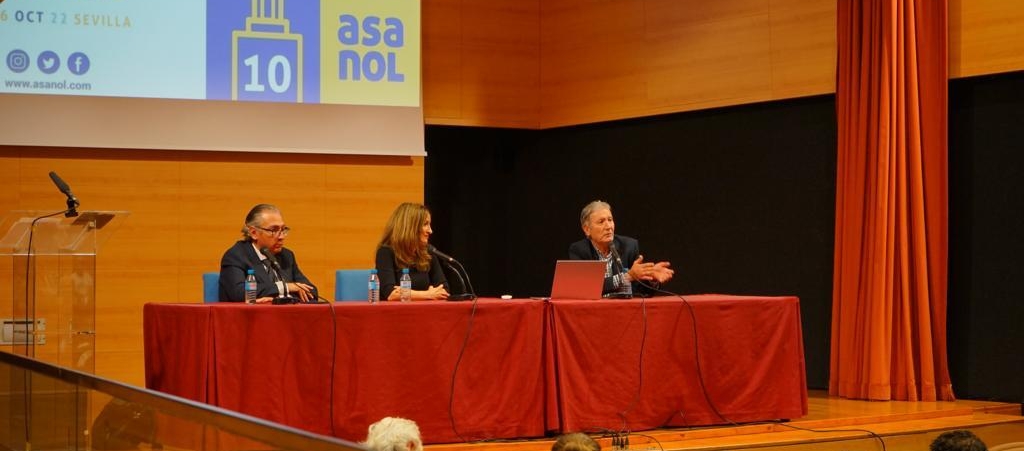
Dr Lorena Castillo, head of the Neuro-Ophthalmology Department and the Teaching Department, leads research on Leber Hereditary Optic Neuropathy (LHON) at various levels. Her extensive experience has attracted the attention of many patients to the Neuro-Ophthalmology Department of ICR, where she regularly provides consultations on the disease.
The ICR Neuro-Ophthalmology Department does a great deal of proactive research and dissemination through publications, conferences, symposia, interviews and other communication channels. Below is a list of some of the most important examples of this.
LHON is a disease that causes a severe and sudden loss of vision and mainly affects young men (between 15 and 25 years old) with a family history of blindness. The main cause is a mutation in mitochondrial DNA, but other genetic and environmental factors are also involved.
At present, there is no definitive treatment; the prognosis is usually permanent and severe loss of vision. However, research into the disease is progressing. There is a drug approved by the European Medicines Agency, idebenone, which has been shown to be beneficial in approximately 50% of cases, though it has not yet obtained funding from the Ministry of Health, as LHON patient organisations denounce.

Furthermore, the LEROS study, of which Dr Castillo is the main researcher, has analysed the long-term efficacy and safety of this drug. The results of this particular study are about to be published in the scientific literature. The first results of this Phase IV study were announced in 2021, and at the end of 2022, Dr Castillo discussed them broadly at the 98th Congress of the SEO for the first time in Spain.
More recently, Dr Castillo has presented the results of the clinical trial in a meeting of the North American Neuro-Ophthalmology Society (NANOS). In her lecture she announced the main results of LEROS, as well as the secondary results in the patient group who started the treatment within the first year of symptom onset.
In her interview for the DBGen website, Dr Castillo expressed optimism about the drug and also announced that a gene therapy drug is expected to gain approval from the European Medicines Agency.
LHON is the most common mitochondrial disease: it is estimated to affect between 1 in 27,000 and 45,000 people around the world. It is therefore particularly important to discuss it at expert meetings, like it was during the XII MITOCON Conference, which on this occasion was held in Rome.
The speech by the head of the Neuro-Ophthalmology Department of the ICR was the only presentation from Spain at this international meeting, which is aimed at patients and their family members as well as professionals from the scientific community.
The paper was titled “Progress in clinical research for new treatment options for LHON: an exciting landscape for Patients and Clinicians“.
Leber Hereditary Optic Neuropathy is considered a rare disease. There is often a low index of suspicion, since it is also little known among ophthalmologists and neurologists. However, early diagnosis is of great importance, because if treatment is started at an early stage, the likelihood of a favourable response increases.
Dr Castillo’s work also has a dissemination dimension. A good example is the project she coordinates at a national level, the Now Expert Meetings. This initiative, supported by the Spanish Society of Ophthalmology, aims to make this disease more visible and to highlight the importance of early diagnosis, which will require a complete neuro-ophthalmological assessment, complementary examinations to rule out other pathologies, and a genetic analysis of mitochondrial DNA.
The doctor has also recently attended the 23rd Congress of the European Association for Eye and Vision Research (EVER), where she gave the lecture “LHON: from clinical suspicion to differential diagnosis”, as well as the 10th Anniversary congress of ASANOL (Leber’s Optic Nerve Atrophy Association). At the latter conference she participated as an expert, in front of other researchers, but also patients and their families. Dr Castillo was able to give some notes of hope: “Gene therapy is providing promising results in some of the patients who have already been treated in clinical trials. In addition, there are other lines of preclinical research that are very encouraging”.

In the field of science dissemination on this pathology, it is worth mentioning this study published in Acta Ophthalmologica last May: “Quantitative assessment of macular and circumpapillary retinal vessel density across all stages of Leber hereditary optic neuropathy using swept source optical coherence tomography angiography“.
Several authors participated in this study, most of whom were members of the Research Department, optometrists and ophthalmologists at the ICR. It has also received the first Ramon Martí i Bonet prize in ophthalmological research 2022, awarded last January at the Barcelona College of Physicians.
Beyond the strictly medical dimension, patients with Leber Hereditary Optic Neuropathy face stigma and a variety of psychological and social problems.
In this interview for Canal Retina, Dr Castillo explains some of the situations encountered by patients. Because it affects especially the central part of vision but not its peripheral part, LHON still allows many patients to do some activities without assistance, such as walking outdoors. However, people with LHON continue to suffer from severe vision impairment. This creates a lot of incomprehension among people around them and, especially a few years ago, among medical staff as well. Some cases have been referred to psychiatry because of this incomprehension, which is due to the lack of knowledge about the disease.
The obstacles that these patients have to overcome are both on a large scale (they cannot read, recognise faces, drive, etc.) and in less significant activities. Fortunately, there are organisations such as ASANOL, which are working for the implementation of improvements at all levels for people with LHON.
The doctor will continue to take part in active research, to collaborate with associations such as ASANOL and to disseminate information at congresses and in publications of all kinds. Her next intervention will be in October, at the 2nd Neuro-Ophthalmology Conference at the Hospital del Mar. She will also combine her research activity with medical appointments, which she still offers in the Neuro-Ophthalmology Department at ICR.
Contact us or request an appointment with our medical team.